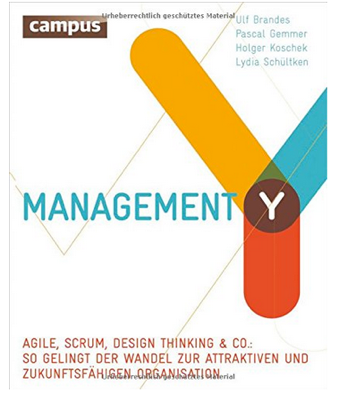Management Y by Brandes, Gemmer, Koschek, Schültken (2014)
The book was published 2014 by Campus and written by the four authors Brandes, Gemmer, Koschek and Schültken, all of whom are working in the consultancy field. Brandes is also involved in the gratifying “New Work Project Augenhöhe (eye level)“. The book is very colorful and reminds you of former editions of the Business Model Generation by Campus, which were also designed with much effort and skill… that is with many pictures, large-format photos, illustrations, quotations, room for discoveries - but in doing so always on the edge of a picture book.

Let’s look at the most important part: the content. As the title suggests, the book deals with the present management, because that is the Generation Y - the so-called millenials - born from ´77-´98, who represent the transition from the twentieth century (“old working world“) into the new millennium (“new working world /new work“). Thus, it is about cultural change, new working forms, digitalisation, design thinking, scrum, authentic company communication and: “It can be done differently - namely better“. Instead of controlling - enabling development, instead of planning everything ahead - discovering step by step, instead of remote-controlled - independent, and instead of subordination - participation. Simplified one could say: It is about unfolding potential.
The book is structured in four chapters. The first chapter unfolds basics for a more humane management. It deals with the differentiation between theory X and Y (see McGregor’s statements from the 60s), flow (see Csikszentmihalyi), sense, participation and complexity. Not new, but in a compressed version.
In the second chapter the authors highlight the current challenges of organisations from four perspectives: customer need, flexible delivery, company culture and company communication. If you are wondering why exactly these four dimensions were selected, then we are both thinking the same. It seems a bit at random. Nevertheless, the chapter offers interesting insights into challenges that organisations are confronted with today. These are also not new, book shelves are filled with it, but they have been brought up to date, which makes this chapter attractive. Furthermore, they are offering innovative approaches that presumably not everyone has heard of yet: “design thinking“, “lean start up“, “minimum viable product“, “open innovation“ etc.
The most exciting to read is chapter three, in which the authors and guest authors introduce 24 possibilities of designing change from practice. This ranges from alternative possibilities within the scope of job interviews (“ask the applicant“) over creativity workshops (“slack“) up to the implementation of larger change processes (“fearless journey“).
Chapter four irritates at first if you follow the introduction. It is supposed to deliver perspectives beyond the aspects listed in the book. However, further ideas from the different disciplines are listed in the following (e.g. “story telling“, “appreciative communication, “Improvisation theater“ among other things), that as well describe how organisations can be shaped in a future-oriented way. At this point we could have much rather imagined a critical position, stating the real barriers, failures or even concrete case studies of companies, that the authors have accompanied in change processes. Instead there is another series of enumerations that lack a general context and a structure.
What else is there? Many links refer to the website, in case you want to dive deeper. On the one hand a good possibility to make more information available to interested readers. However, if you go to the website there is only slightly more information. Here it would have been nicer to simply illustrate it in a small box in the book.
Gratifying are the suggestions for participation, that can be found throughout the entire book and the spirit of giving feedback and of being a part of the movement. That has a real convincing effect and directly implements the most important messages. Astonishing, however, that until the end of August 2015 - despite a positive response by the press - no one has made use of it so far, at least not on the website itself.
Result:
In total the book offers a good illustration of current trends of the new working forms in the 21st century and partly of fresh methods that should not only accommodate the so-called generation Y, but should also represent contemporary concepts for the organisation in the present and the future. We think this book is especially suitable for organisation consultants and employees from the field of personnel and organisation development.

